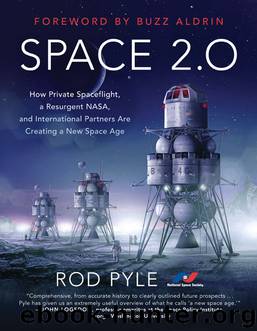Space 2.0 by Rod Pyle

Author:Rod Pyle
Language: eng
Format: epub
Publisher: BenBella Books, Inc.
Published: 2019-01-01T16:00:00+00:00
§120.1 General authorities, receipt of licenses, and ineligibility.
Section 38 of the Arms Export Control Act (22 U.S.C. 2778), as amended, authorizes the President to control the export and import of defense articles and defense services. The statutory authority of the President to promulgate regulations with respect to exports of defense articles and defense services is delegated to the Secretary of State by Executive Order 13637. This subchapter implements that authority, as well as other relevant authorities in the Arms Export Control Act (22 U.S.C. 2751 et seq.). By virtue of delegations of authority by the Secretary of State, these regulations are primarily administered by the Deputy Assistant Secretary of State for Defense Trade Controls, Bureau of Political-Military Affairs.98
In practical terms, ITAR limits transactions involving obvious sorts of defense articles, such as weapons and ammunition, but can also apply to computer software and hardware, along with various commonplace technologies for which military use might be found. That includes many of the crucial components for a space program. To complicate matters further, different potential partners are covered by different restrictions. While it’s not impossible for NASA to work with most international partners, it can be a very convoluted process.99
I asked Charles Elachi, the former director of NASA’s Jet Propulsion Laboratory, for his thoughts on internationalism and space projects. JPL has worked with foreign partners for decades—indeed, the first cooperation in space science occurred during its robotic exploration programs of the 1960s—and Elachi has amassed vast experience in the complicated processes involved.
“I think international cooperation is essential. Most missions at JPL have some level of international collaboration, but it has to be done thoughtfully. I can give you two perfect examples. One is the Cassini–Huygens mission—the Europeans built the Huygens probe, and we did the rest. Another was the TOPEX Poseidon ocean observing system. We got twice the value for our money with that mission. So I think international collaboration is the way of the future.”100 In both projects Elachi cited, European partners tackled difficult technological challenges and provided support during the mission, saving NASA a worthy percentage of the project cost—about $500 million on Cassini alone.101
Download
This site does not store any files on its server. We only index and link to content provided by other sites. Please contact the content providers to delete copyright contents if any and email us, we'll remove relevant links or contents immediately.
| Aerodynamics | Aircraft Design & Construction |
| Astronautics & Space Flight | Avionics |
| Gas Dynamics | Propulsion Technology |
Whiskies Galore by Ian Buxton(41937)
Introduction to Aircraft Design (Cambridge Aerospace Series) by John P. Fielding(33092)
Small Unmanned Fixed-wing Aircraft Design by Andrew J. Keane Andras Sobester James P. Scanlan & András Sóbester & James P. Scanlan(32764)
Craft Beer for the Homebrewer by Michael Agnew(18196)
Turbulence by E. J. Noyes(7977)
The Complete Stick Figure Physics Tutorials by Allen Sarah(7338)
Kaplan MCAT General Chemistry Review by Kaplan(6899)
The Thirst by Nesbo Jo(6877)
Bad Blood by John Carreyrou(6581)
Modelling of Convective Heat and Mass Transfer in Rotating Flows by Igor V. Shevchuk(6406)
Learning SQL by Alan Beaulieu(6237)
Weapons of Math Destruction by Cathy O'Neil(6214)
Man-made Catastrophes and Risk Information Concealment by Dmitry Chernov & Didier Sornette(5956)
Digital Minimalism by Cal Newport;(5704)
Life 3.0: Being Human in the Age of Artificial Intelligence by Tegmark Max(5514)
iGen by Jean M. Twenge(5385)
Secrets of Antigravity Propulsion: Tesla, UFOs, and Classified Aerospace Technology by Ph.D. Paul A. Laviolette(5333)
Design of Trajectory Optimization Approach for Space Maneuver Vehicle Skip Entry Problems by Runqi Chai & Al Savvaris & Antonios Tsourdos & Senchun Chai(5037)
Pale Blue Dot by Carl Sagan(4953)
